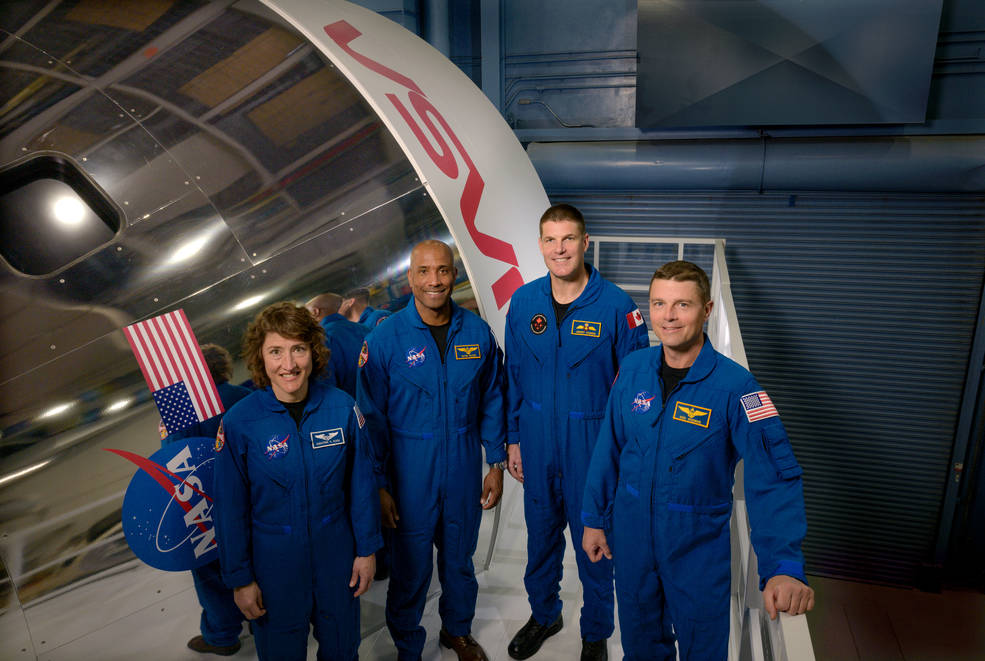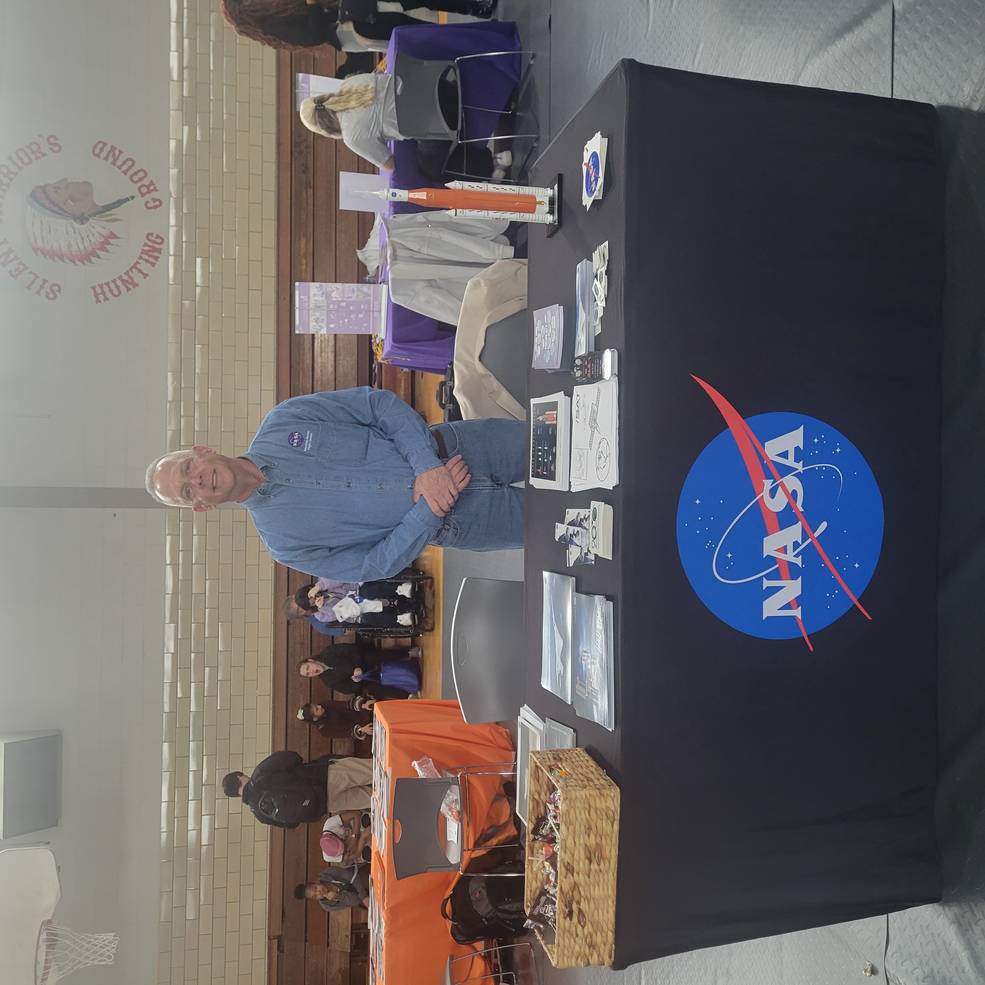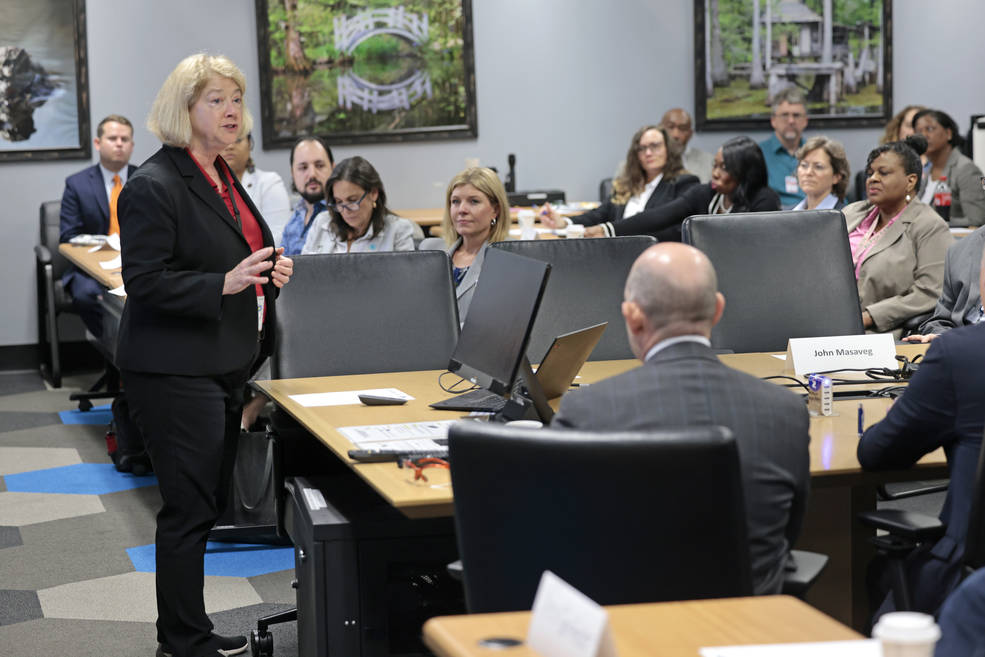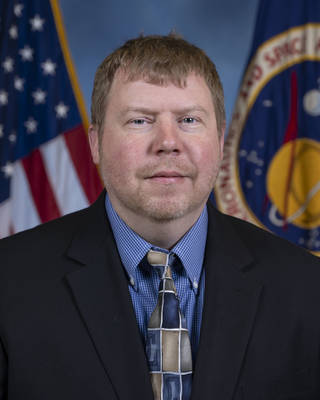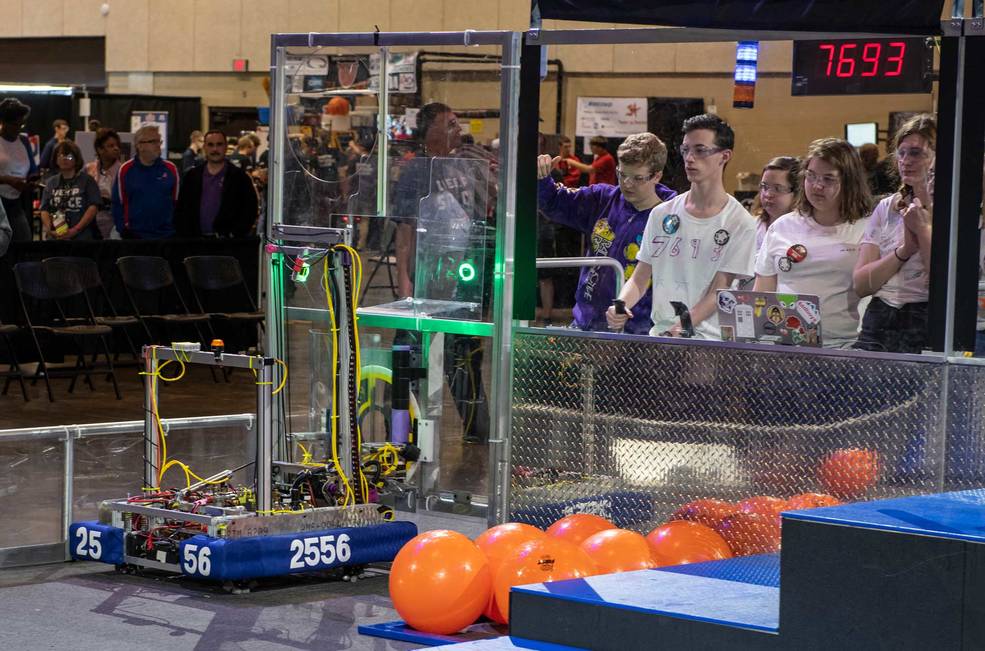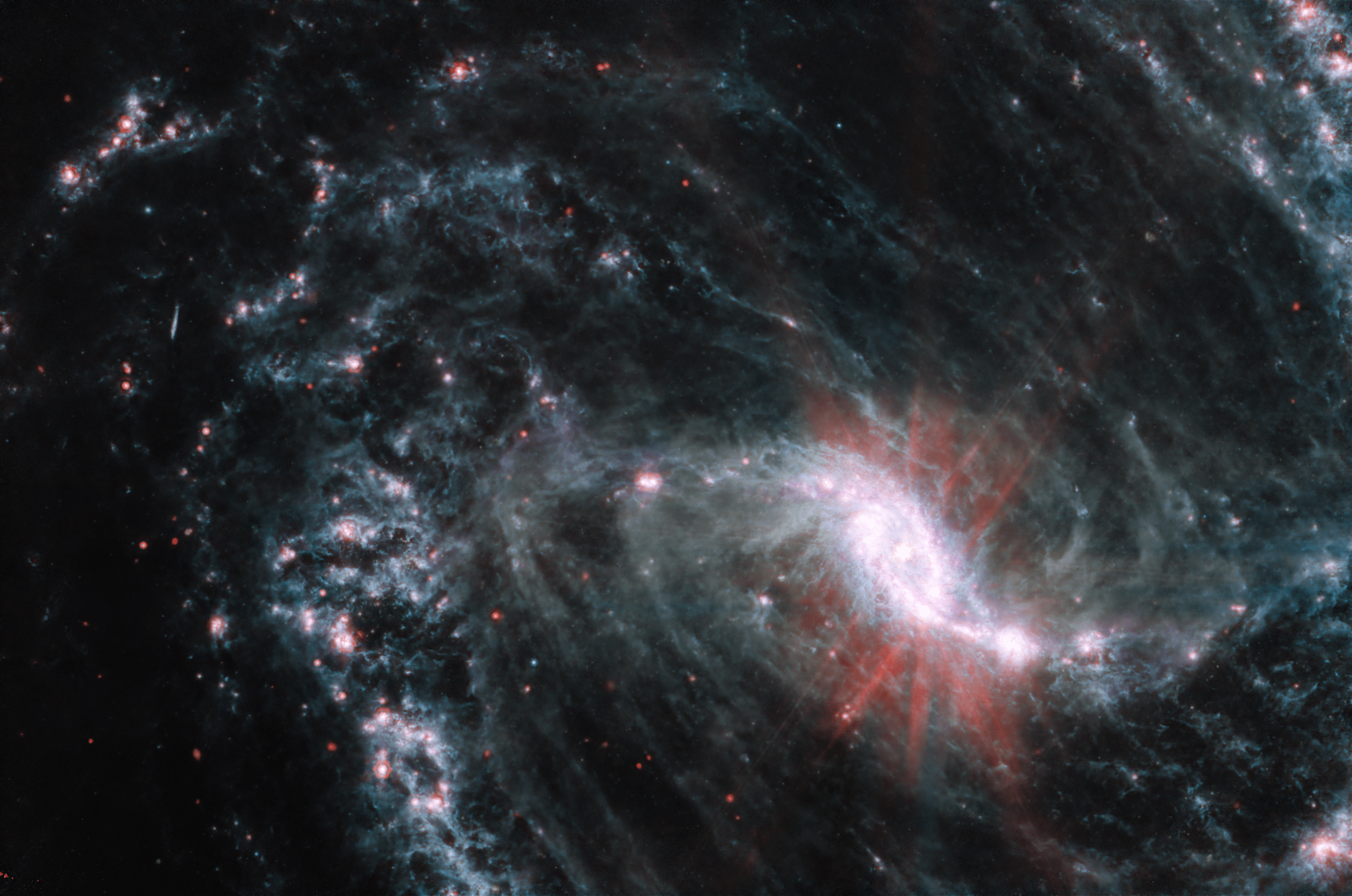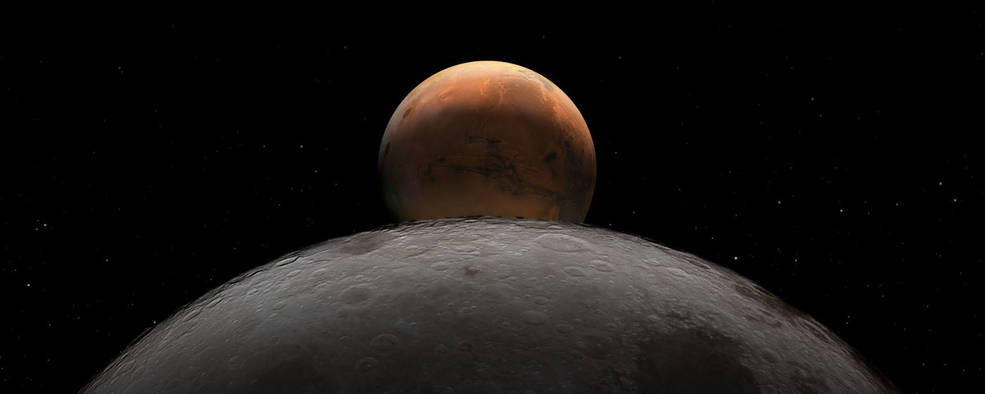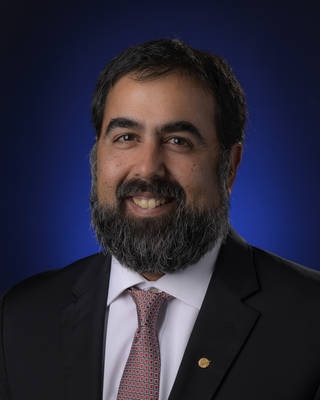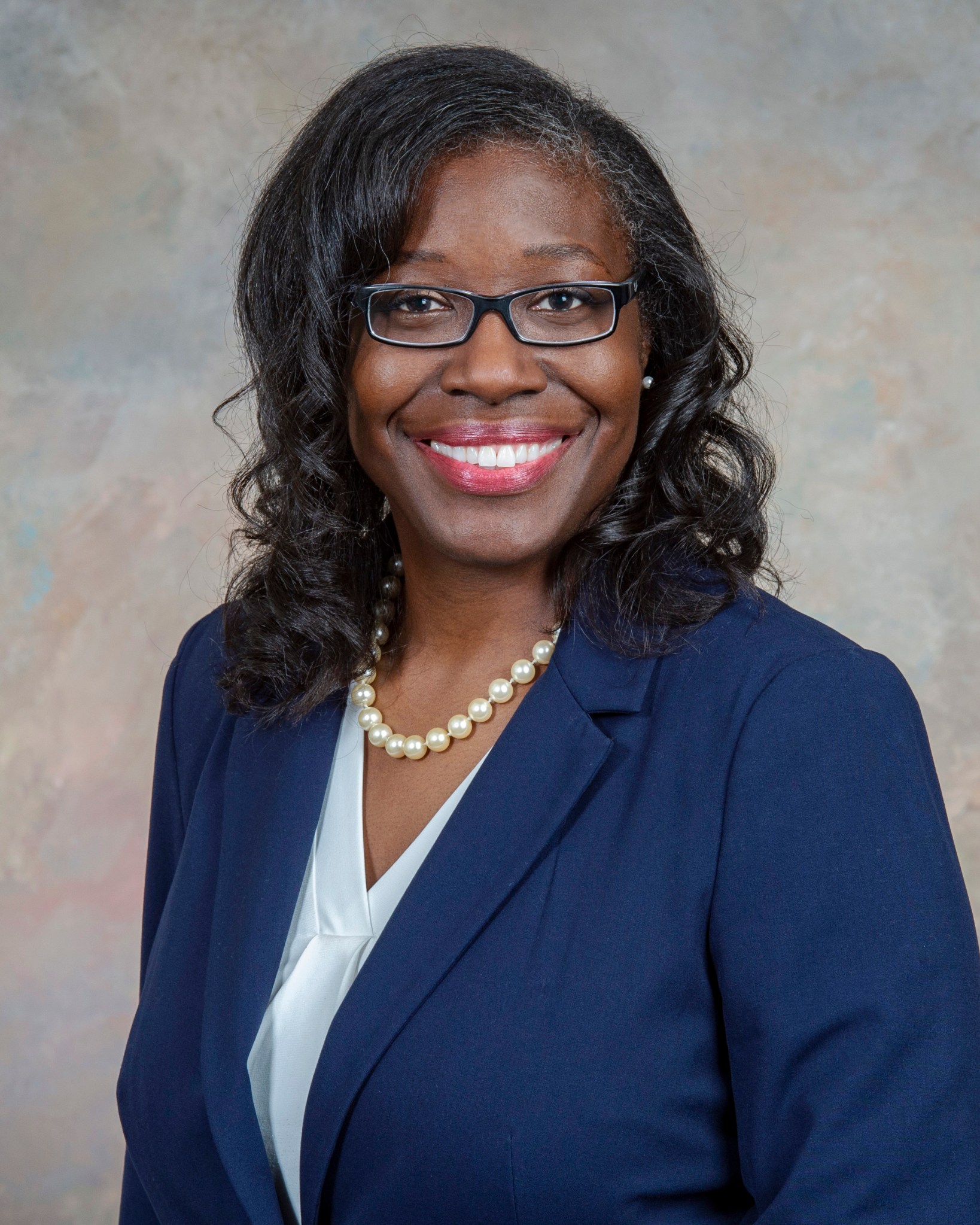The Marshall Star for April 5, 2023.
In This Week’s Star
- NASA Names Astronauts to Next Moon Mission, First Crew Under Artemis
- Chip Dobbs: Embodying the Importance of Human Connection and Giving Back
- Manufacturing Partnership Seeks to StrengthenEmployment Pipeline at Michoud
- Jason Turpin Named Senior Technical Leader of Space Nuclear Propulsion
- Annual FIRST Robotics Competition Returns to Rocket City on April 6-8
- NASA Receives Top Honor of Best Place to Work in Federal Government
- New Program Office Leads NASA’s Path Forward for Moon, Mars
- Hubble Finds Saturn’s Rings Heating Its Atmosphere
- OSIRIS-REx Sample Return Mission Featured on ‘This Week at NASA’
NASA Names Astronauts to Next Moon Mission, First Crew Under Artemis
NASA and the Canadian Space Agency (CSA) announced the four astronauts who will venture around the Moon on Artemis II, the first crewed mission on NASA’s path to establishing a long-term presence at the Moon for science and exploration through Artemis. The agencies revealed the crew members April 3 during an event at Ellington Field near NASA’s Johnson Space Center.
“The Artemis II crew represents thousands of people working tirelessly to bring us to the stars. This is their crew, this is our crew, this is humanity’s crew,” said NASA Administrator Bill Nelson. “NASA astronauts Reid Wiseman, Victor Glover, and Christina Hammock Koch, and CSA astronaut Jeremy Hansen, each has their own story, but, together, they represent our creed: E pluribus unum – out of many, one. Together, we are ushering in a new era of exploration for a new generation of star sailors and dreamers – the Artemis Generation.”
The crew assignments are as follows: Commander Reid Wiseman, Pilot Victor Glover, Mission Specialist 1 Christina Hammock Koch, and Mission Specialist 2 Jeremy Hansen. They will work as a team to execute an ambitious set of demonstrations during the flight test.
The approximately 10-day Artemis II flight test will launch on the agency’s powerful Space Launch System rocket, prove the Orion spacecraft’s life-support systems, and validate the capabilities and techniques needed for humans to live and work in deep space.
“We are going back to the Moon and Canada is at the center of this exciting journey,” said the Honorable François-Philippe Champagne, the minister responsible for the Canadian Space Agency. “Thanks to our longstanding collaboration with NASA, a Canadian astronaut will fly on this historic mission. On behalf of all Canadians, I want to congratulate Jeremy for being at the forefront of one of the most ambitious human endeavors ever undertaken. Canada’s participation in the Artemis program is not only a defining chapter of our history in space, but also a testament to the friendship and close partnership between our two nations.”
The flight, set to build upon the successful uncrewed Artemis I mission completed in December, will set the stage for the first woman and first person of color on the Moon through the Artemis program, paving the way for future for long-term human exploration missions to the Moon, and eventually Mars. This is the agency’s Moon to Mars exploration approach.
“For the first time in more than 50 years, these individuals – the Artemis II crew – will be the first humans to fly to the vicinity of the Moon. Among the crew are the first woman, first person of color, and first Canadian on a lunar mission, and all four astronauts will represent the best of humanity as they explore for the benefit of all,” said Director Vanessa Wyche, NASA Johnson. “This mission paves the way for the expansion of human deep space exploration and presents new opportunities for scientific discoveries, commercial, industry and academic partnerships and the Artemis Generation.”
This will be Wiseman’s second trip into space, serving previously as a flight engineer aboard the International Station for Expedition 41 from May through November 2014. Wiseman has logged more than 165 days in space, including almost 13 hours as lead spacewalker during two trips outside the orbital complex. Prior to his assignment, Wiseman served as chief of the Astronaut Office from December 2020 until November 2022.
The mission will be Glover’s second spaceflight, serving previously as pilot on NASA’s SpaceX Crew-1, which landed May 2, 2021, after 168 days in space. As a flight engineer aboard the space station for Expedition 64, he contributed to scientific investigations, technology demonstrations, and participated in four spacewalks.
Koch also will be making her second flight into space on the Artemis II mission. She served as flight engineer aboard the space station for Expedition 59, 60, and 61. Koch set a record for the longest single spaceflight by a woman with a total of 328 days in space and participated in the first all-female spacewalks.
Representing Canada, Hansen is making his first flight to space. A colonel in the Canadian Armed Forces and former fighter pilot, Hansen holds a Bachelor of Science in space science from Royal Military College of Canada in Kingston, Ontario, and a Master of Science in physics from the same institution in 2000, with a research focus on Wide Field of View Satellite Tracking. He was one of two recruits selected by CSA in May 2009 through the third Canadian Astronaut Recruitment Campaign and has served as Capcom in NASA’s Mission Control Center at Johnson and, in 2017, became the first Canadian to be entrusted with leading a NASA astronaut class, leading the training of astronaut candidates from the United States and Canada.
“I could not be prouder that these brave four will kickstart our journeys to the Moon and beyond,” said Director of Flight Operations Norm Knight, NASA Johnson. “They represent exactly what an astronaut corps should be: a mix of highly capable and accomplished individuals with the skills and determination to take on any trial as a team. The Artemis II mission will be challenging, and we’ll test our limits as we prepare to put future astronauts on the Moon. With Reid, Victor, Christina, and Jeremy at the controls, I have no doubt we’re ready to face every challenge that comes our way.”
Through Artemis missions, NASA will use innovative technologies to explore more of the lunar surface than ever before. We will collaborate with commercial and international partners and establish the first long-term presence on the Moon. Then, we will use what we learn on and around the Moon to take the next giant leap: sending the first astronauts to Mars.
Chip Dobbs: Embodying the Importance of Human Connection and Giving Back
By Lane Figueroa
William “Chip” Dobbs III is a supply management specialist at NASA’s Marshall Space Flight Center, where he has worked for 29 years.
Dobbs is also deaf. But instead of this disability holding him back, it has become a gateway to inspire and connect with others. His admiration for people and human connection are obvious to those who cross paths with him.
“Chip’s biggest contribution to Marshall is his ability to work with everyone to support logistics,” said Raymond Bradley, Dobbs’ supervisor. “Even with his hearing disability, he strives to understand what the customer needs and works tremendously hard to provide the support requested.”
As a supply management specialist, Dobbs monitors personnel moves and furniture support for the contractor workforce and supports all logistics functions at Marshall – a critical job at the center as more employees return to on-site work.
During the COVID-19 pandemic, Dobbs tackled major projects that were different than his normal duties, including the Warehouse Reduction Project and issuing personal protective equipment.
Dobbs deeply values his role in the bigger NASA picture. “Without logistics, the mission simply cannot be accomplished,” Dobbs said. “But the people are my favorite part about my job.”
Dobbs’ impressive career is just a glance into his life’s story and hearty character. In addition to his accomplishments at Marshall, Dobbs dedicates his time to giving back to an organization that shaped his life – the Alabama Institute for Deaf and Blind (AIDB). Dobbs was the valedictorian of the Alabama School for the Deaf class of 1981, and has been on the AIDB Board of Trustees at-large for more than 20 years.
AIDB manages multiple locations and schools throughout Alabama, impacting the lives of thousands of individuals with hearing and vision loss and their families.
Dobbs frequently travels to the school’s headquarters in Talladega to visit students and attend outreach events. He’s also helped facilitate tours of Marshall and the U.S. Space & Rocket Center in Huntsville. Dobbs has become a familiar face to the children of AIDB and serves as a beacon of hope and inspiration.
“Every time I go down to Talladega, the children come running to me,” Dobbs said. “I often wear a NASA shirt, which catches their attention and entices them to ask questions about how they could work for NASA one day.”
Most recently, Dobbs attended the AIDB Career Day on March 17 in Talladega, along with Marshall Deputy Director of Human Resources Larry Mack and Marshall Deputy Director of the Office of Diversity and Equal Opportunity Carolyn Magsby. The event served to expose high school students to various career fields, including opportunities in science, technology, engineering, and math.
“During our time at the AIDB Career Day, Chip’s smile and manner in which he shared his love for AIDB and his NASA job helped students relax and eased their jitters,” Mack said. “Chip told the students that they can be anything they wanted by working hard and being lifelong learners.”
Dobbs said he always emphasizes the importance of education when he meets with students. He credits the school with equipping him with the skills to navigate the world with a disability. Following high school, Dobbs earned a degree in human resource management from Athens State University.
Dobbs’ involvement with AIDB contributes to NASA’s vision to reach more of the Artemis Generation – the future engineers, scientists, and explorers who will shape the future of space exploration. NASA’s Office of Diversity and Equal Opportunity places a special emphasis on recruiting and providing the appropriate resources for those with disabilities.
“We should continue to reach and inspire those with disabilities,” Dobbs said. “They, too, have the power to change the world.”
Dobbs’ passion for human connection expands across every facet of his life. He advocates for and represents that it takes a diverse workforce to achieve the great feats of space exploration.
“Chip’s overwhelming desire to help anyone he connects with is a true testament to his commitment to ensure each AIDB student understands that anything is possible, if you never give up, believe, and have confidence in yourself,” Mack said.
Figueroa, a Media Fusion employee, supports Marshall’s Office of Strategic Analysis & Communications.
Manufacturing Partnership Seeks to Strengthen Employment Pipeline at Michoud
By Heather Keller
A regional partnership that includes NASA’s Michoud Assembly Facility aims to build a pipeline for future aerospace workers.
On March 31, local, state, federal, and agency leaders gathered at Michoud to officially launch the Greater New Orleans Regional Advanced Manufacturing Partnership (GNO RAMP), a workforce development program.
The partnership, led by Greater New Orleans Inc., is a coalition that includes the U.S. government, private industry, higher education, and training groups, as well as philanthropic organizations. The program supports initiatives from the National Space Council and Vice President Kamala Harris, which promotes aerospace STEM efforts to inspire, prepare, and employ future aerospace workers.
NASA Deputy Administrator Pam Melroy attended the event and spoke to the coalition, thanking them for their commitment and emphasizing how the partnership will benefit the aerospace industry. Her visit – and the launch of the development program – comes as NASA and Boeing, the SLS core stage lead contractor, continue to make progress building core stages for future Space Launch System (SLS) rockets at Michoud. All the core stages that help power the SLS rocket are built and assembled at Michoud, including the Artemis II mission. Teams are also working on the Exploration Upper Stage, a more powerful in-space stage that will enable SLS to deliver heavier cargos to deep space beginning with Artemis IV.
“Look at the NASA mission: we don’t get anything done without our skilled workforce,” Melroy said. “What we have here is a pilot that is then a playbook that we can replicate throughout the country. So that is the significance of the work that you’re doing, the things that you do are actually going to impact the success of the Artemis program, and feel free to use Artemis to inspire that next generation.”
GNO RAMP is one of only three pilot programs of its kind throughout the country, according to Dr. Quincy Brown, National Space Council director of Space STEM and Workforce Policy. “We do recognize that the need for a skilled, trained workforce exists across the country – throughout the industry,” Brown said. “We want people to be on the path, but we want there to be an actual job at the end of that path.”
Following the initial welcomes, GNO RAMP partners participated in a roundtable discussion where industry and education professionals expressed areas of need within the workforce and potential opportunities in STEM education. The dialogue included ways to reach out to students at both middle and high school levels to help them understand the potential opportunities available, and how to connect them to industry.
GNO RAMP is “essentially a sectoral partnership here in the region that is bringing all the folks together and focusing on industry-driven ecosystem supported and targeted actions to develop our workforce here in the region,” said Josh Tatum, director of Strategic Initiatives for GNO.
GNO RAMP is the culmination of a growing relationship between Michoud, GNO, the Louisiana Board of Regents, and higher education, which has spent recent years workshopping ideas on creating a sustainable, skilled workforce. “We’re proud to be a part of an initiative that will strengthen the home-grown talent pool here in New Orleans and throughout the region for years to come,” said Michoud Director Lionel Dutreix. “This partnership embodies Michoud’s commitment to our community and STEM outreach efforts.”
The group closed out the day with a tour of Michoud’s rocket factory, where attendees saw real-time examples of advanced manufacturing opportunities available to the future workforce, including the nearly completed core stage for Artemis II.
Keller, a Manufacturing Technical Solutions Inc. employee, supports Michoud Assembly Facility.
Jason Turpin Named Senior Technical Leader of Space Nuclear Propulsion
Jason Turpin has been named to the position of senior technical leader of Space Nuclear Propulsion in the Science and Technology Office at NASA’s Marshall Space Flight Center. He will be the agency’s senior leader for all of NASA’s Space Nuclear Propulsion development activities.
Turpin was previously Space Nuclear Propulsion project manager for the Space Technology Mission Directorate’s Technology Demonstration Program, and he worked in support of the Space Nuclear Technologies portfolio manager. He was responsible for the overall technical and administrative direction of the project, including advancing and maturing NASA’s fission-based space nuclear propulsion technologies and capabilities and developing and demonstrating both nuclear thermal and nuclear electric propulsion system capabilities that are needed for NASA’s future missions.
Turpin has 23 years of experience supporting, leading, and managing diverse, multidiscipline, matrixed teams developing, testing, certifying, and operating complex and advanced space transportation systems and their subsystems at Marshall. He has performed technical leadership, supervisory, project management, and program management roles supporting the Space Nuclear Propulsion Project, Human Landing System, Space Launch System (SLS), International Space Station, Commercial Resupply Services, Commercial Crew Program, and other agency programs.
Turpin received a bachelor’s degree in mechanical engineering from Christian Brothers University in Memphis, Tennessee. He lives in Madison with his wife, Alicia, and two daughters.
Annual FIRST Robotics Competition Returns to Rocket City on April 6-8
The Rocket City Regional – Alabama’s annual FIRST Robotics Competition – will be held April 6-8 at the Von Braun Center South Hall in Huntsville. This event is free and open to the media, public, and children.
More than 1,000 high school students on 50 teams from 15 states, Mexico, and Brazil will compete in a new robotics game called “CHARGED UP.”
Opening ceremonies begin at 8:30 a.m. CDT on April 7 and April 8, with qualification matches underway at 9 a.m. each day. The April 7 awards ceremony will begin at 6 p.m., while the April 8 awards ceremony will begin at 2:30 p.m.
FIRST Robotics is a global robotics competition for students in grades 9-12. Teams are challenged to raise funds, design a team brand, hone teamwork skills, and build and program industrial-sized robots to play a difficult field game against competitors.
District and regional competitions – such as the Rocket City Regional – are held across the country during March and April, providing teams a chance to qualify for the 2023 FIRST Robotics Competition Championship events held in late April in Houston.
NASA and its Robotics Alliance Project provide grants for high school teams and support for FIRST Robotics Competition to address the critical national shortage of students pursuing STEM careers. This FIRST Robotics Competition is supported by NASA’s Marshall Space Flight Center and NASA’s Office of STEM Engagement.
For Rocket City Regional event information, visit here. For more information about Marshall’s support for education programs, visit here.
NASA Receives Top Honor of Best Place to Work in Federal Government
NASA is taking home the honor of the Best Place to Work in the Federal Government among large agencies for 11 years in a row, as ranked by the Partnership for Public Service.
The rankings, announced March 29, reflect the agency’s dedication to pursue missions of discovery and exploration, including sending humans farther into space than ever before for the benefit of humanity.
The team at NASA’s Marshall Space Flight Center has played a significant role in this achievement, according to Center Director Jody Singer.
“I am proud of all we accomplished at Marshall in 2022, from exploring the universe’s depths through NASA’s Imaging X-Ray Polarimetry Explorer to our critical role in successfully launching the Artemis I test flight – none of this would be possible without our incredibly dedicated and skilled workforce,” Singer said. “I truly believe people are our strength, so it is no surprise NASA was once again named the best place to work in the federal government. Our talented and diverse team at Marshall is poised to do even more this year, starting with developing innovative technologies like the Mars Ascent Vehicle, advanced habitation systems, and Space Nuclear Propulsion that will help take humanity safely and quickly to the Moon, Mars and beyond.”
The Best Places to Work in the Federal Government rankings are based on responses to the Office of Personnel Management’s annual Federal Employee Viewpoint Survey from almost 557,778 federal workers and an additional 326,300 employees at 14 agencies that conducted separate surveys at the same time and had a response rate of more than 50%. The Partnership for Public Service began publishing the rankings in 2003.
This year, the Partnership for Public Service and Boston Consulting Group, in collaboration with The Washington Post, released an advanced look at a portion of the 2022 Best Places to Work in the Federal Government rankings and data. This special edition featured the rankings of the top 10 agencies in four categories – large, midsize, and small agencies as well their subcomponents.
“In 2022, NASA unfolded the universe with the James Webb Space Telescope, achieved a watershed moment for planetary protection with DART impact, and took a giant leap in our journey back to the Moon and onward to Mars with launch and recovery of the Artemis I flight test. These missions – and every NASA mission – are an achievement made possible by our unrivaled team,” said NASA Administrator Bill Nelson. “The passion and precision of our workforce makes NASA the best place to work in the federal government. Together, we are poised to accomplish more daring feats with new advancements, more scientific contributions on Earth and in the heavens, and more incredible technological breakthroughs that will help shape the 21st century.”
The complete list of rankings for the Best Places to Work is available online.
New Program Office Leads NASA’s Path Forward for Moon, Mars
NASA has established the new Moon to Mars Program Office at NASA Headquarters to carry out the agency’s human exploration activities at the Moon and Mars for the benefit of humanity. Amit Kshatriya will serve as the agency’s first head of the office, effective immediately.
This new office resides within the Exploration Systems Development Mission Directorate, reporting to its Associate Administrator Jim Free.
“The Moon to Mars Program Office will help prepare NASA to carry out our bold missions to the Moon and land the first humans on Mars,” said NASA Administrator Bill Nelson. “The golden age of exploration is happening right now, and this new office will help ensure that NASA successfully establishes a long-term lunar presence needed to prepare for humanity’s next giant leap to the Red Planet.”
As directed by the 2022 NASA Authorization Act, the Moon to Mars Program Office focuses on hardware development, mission integration, and risk management functions for programs critical to the agency’s exploration approach that uses Artemis missions at the Moon to open a new era of scientific discovery and prepare for human missions to Mars. This includes the Space Launch System rocket, Orion spacecraft, supporting ground systems, human landing systems, spacesuits, Gateway, and more related to deep space exploration. The new office will also lead planning and analysis for long-lead developments to support human Mars missions.
Kshatriya previously served as acting deputy associate administrator for Common Exploration Systems Development, providing leadership and integration across several of the programs that now fall within the new office.
Lakiesha Hawkins, deputy manager of the Human Landing System (HLS) program at NASA’s Marshall Space Flight Center,will serve as the deputy for the Moon to Mars Program Office. As deputy, Hawkins will support Kshatriya in all aspects of the office’s day-to-day management and operations. Stephen Creech will serve as the technical deputy for the office. In this capacity, Creech will be responsible for ensuring technical issues are identified and brought to resolution across all offices and programs under the Moon to Mars Program Office.
Updates to the mission directorate also include the Strategy and Architecture Office that develops the integrated master plan based on the agency Moon to Mars Objectives, alongside NASA’s Science, Space Technology, and Space Operations Mission Directorates. With these changes, NASA will continue to lead the nation in exploration while also building a coalition of international partners in deep space with the Artemis Accords.
Since establishing its Exploration Systems Mission Directorate in September 2021, NASA has worked diligently to assess and align its two human spaceflight organizations while remaining focused on Artemis and other agency mission priorities including International Space Station operations, commercial crew and cargo, and more.
The Space Operations Mission Directorate remains responsible for all low-Earth orbit space operations and is focused on the space station, space communications and navigation supporting all NASA human and science exploration missions, as well as a continued development of a vibrant and expanding commercial space economy closer to home. Space Operations also manages the Launch Services Program, Commercial Crew Program, Commercial Low Earth Orbit Development Program, Human Spaceflight Capabilities, and other associated resources.
Other organizational updates include a business function for each mission directorate to manage administrative processes and financial formulation, and the exploration operations function will report to the Moon to Mars Program to maximize efficiency for integrated risk management with the relevant hardware programs supporting Artemis missions.
Through Artemis, NASA will land the first woman and the first person of color on the Moon, paving the way for a long-term, sustainable lunar presence to explore more of the lunar surface than ever before and prepare for future astronaut missions to Mars. This is NASA’s Moon to Mars exploration approach.
Hubble Finds Saturn’s Rings Heating Its Atmosphere
The secret has been hiding in plain view for 40 years. But it took the insight of a veteran astronomer to pull it all together within a year, using observations of Saturn from NASA’s Hubble Space Telescope and retired Cassini probe, in addition to the Voyager 1 and 2 spacecraft and the retired International Ultraviolet Explorer mission.
The discovery: Saturn’s vast ring system is heating the giant planet’s upper atmosphere. The phenomenon has never before been seen in the solar system. It’s an unexpected interaction between Saturn and its rings that potentially could provide a tool for predicting if planets around other stars have glorious Saturn-like ring systems, too.
The telltale evidence is an excess of ultraviolet radiation, seen as a spectral line of hot hydrogen in Saturn’s atmosphere. The bump in radiation means that something is contaminating and heating the upper atmosphere from the outside.
The most feasible explanation is that icy ring particles raining down onto Saturn’s atmosphere cause this heating. This could be due to the impact of micrometeorites, solar wind particle bombardment, solar ultraviolet radiation, or electromagnetic forces picking up electrically charged dust. All this happens under the influence of Saturn’s gravitational field pulling particles into the planet. When NASA’s Cassini probe plunged into Saturn’s atmosphere at the end of its mission in 2017, it measured the atmospheric constituents and confirmed that many particles are falling in from the rings.
“Though the slow disintegration of the rings is well known, its influence on the atomic hydrogen of the planet is a surprise. From the Cassini probe, we already knew about the rings’ influence. However, we knew nothing about the atomic hydrogen content,” said Lotfi Ben-Jaffel of the Institute of Astrophysics in Paris and the Lunar & Planetary Laboratory, University of Arizona, author of a paper published on March 30 in the Planetary Science Journal.
“Everything is driven by ring particles cascading into the atmosphere at specific latitudes. They modify the upper atmosphere, changing the composition,” said Ben-Jaffel. “And then you also have collisional processes with atmospheric gasses that are probably heating the atmosphere at a specific altitude.”
Ben-Jaffel’s conclusion required pulling together archival ultraviolet-light (UV) observations from four space missions that studied Saturn. This includes observations from the two NASA Voyager probes that flew by Saturn in the 1980s and measured the UV excess. At the time, astronomers dismissed the measurements as noise in the detectors. The Cassini mission, which arrived at Saturn in 2004, also collected UV data on the atmosphere (over several years). Additional data came from Hubble and the International Ultraviolet Explorer, which launched in 1978, and was an international collaboration between NASA, ESA (European Space Agency), and the United Kingdom’s Science and Engineering Research Council.
But the lingering question was whether all the data could be illusory, or instead reflected a true phenomenon on Saturn.
The key to assembling the jigsaw puzzle came in Ben-Jaffel’s decision to use measurements from Hubble’s Space Telescope Imaging Spectrograph (STIS). Its precision observations of Saturn were used to calibrate the archival UV data from all four other space missions that have observed Saturn. He compared the STIS UV observations of Saturn to the distribution of light from multiple space missions and instruments.
“When everything was calibrated, we saw clearly that the spectra are consistent across all the missions. This was possible because we have the same reference point, from Hubble, on the rate of transfer of energy from the atmosphere as measured over decades,” Ben-Jaffel said. “It was really a surprise for me. I just plotted the different light distribution data together, and then I realized, wow – it’s the same.”
Four decades of UV data cover multiple solar cycles and help astronomers study the Sun’s seasonal effects on Saturn. By bringing all the diverse data together and calibrating it, Ben-Jaffel found that there is no difference to the level of UV radiation. “At any time, at any position on the planet, we can follow the UV level of radiation,” he said. This points to the steady “ice rain” from Saturn’s rings as the best explanation.
“We are just at the beginning of this ring characterization effect on the upper atmosphere of a planet. We eventually want to have a global approach that would yield a real signature about the atmospheres on distant worlds. One of the goals of this study is to see how we can apply it to planets orbiting other stars. Call it the search for ‘exo-rings.’”
The Hubble Space Telescope is a project of international cooperation between NASA and ESA. NASA’s Goddard Space Flight Center manages the telescope. The Space Telescope Science Institute (STScI) in Baltimore conducts Hubble science operations. STScI is operated for NASA by the Association of Universities for Research in Astronomy, in Washington, D.C.
OSIRIS-REx Sample Return Mission Featured on ‘This Week at NASA’
NASA’s OSIRIS-REx team is preparing for the spacecraft to return the sample material it collected from asteroid Bennu. The mission work is featured in “This Week @ NASA,” a weekly video program broadcast on NASA-TV and posted online.
The O-REx sample capsule is expected to touchdown in the Utah desert on Sept. 24 – becoming the first-ever U.S. mission to return an asteroid sample to Earth. OSIRIS-REx is the third mission in NASA’s New Frontiers Program, managed by NASA’s Marshall Space Flight Center for the agency’s Science Mission Directorate.
View this and previous episodes at “This Week @NASA” on NASA’s YouTube page.


























